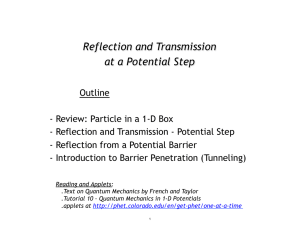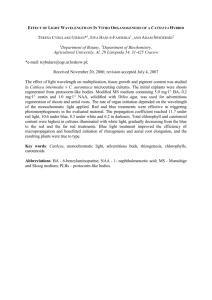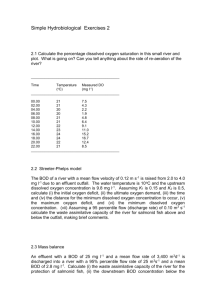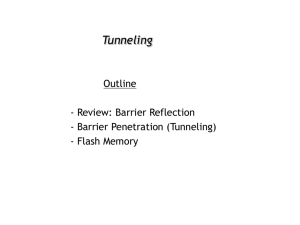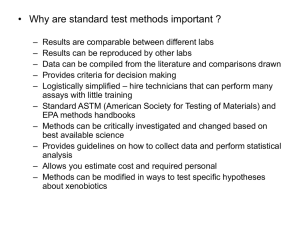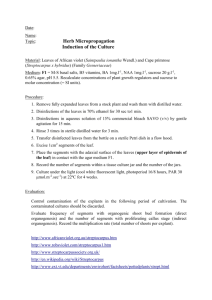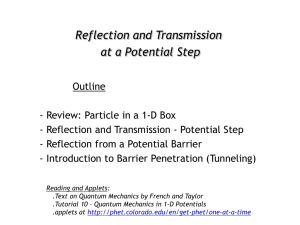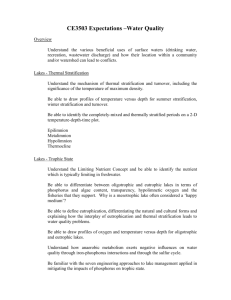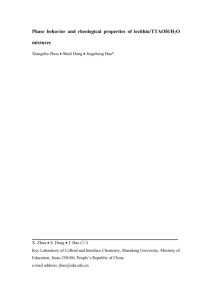Tunneling Outline - Review: Barrier Reflection
advertisement
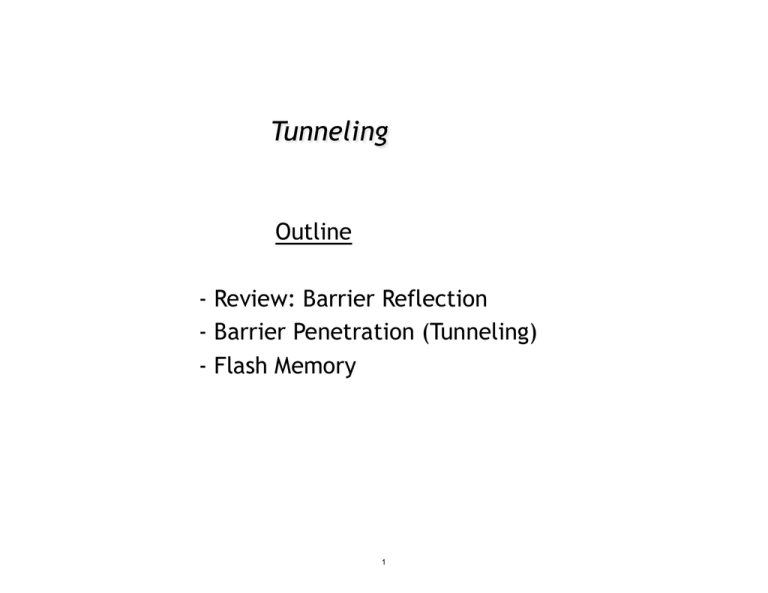
Tunneling Outline - Review: Barrier Reflection - Barrier Penetration (Tunneling) - Flash Memory 1 A Simple Potential Step ψA = Ae−jk1 x ψC = Ce−jk1 x ψB = Be−jk1 x E = Eo V CASE I : Eo > V Region 1 E=0 Region 2 x=0 x In Region 1: 2 ∂ 2 ψ Eo ψ = − 2m ∂x2 k12 2mEo = 2 In Region 2: 2 ∂ 2 ψ (Eo − V ) ψ = − 2m ∂x2 k22 2m (Eo − V ) = 2 2 A Simple Potential Step ψA = Ae−jk1 x ψC = Ce−jk1 x ψB = Be−jk1 x V CASE I : Eo > V Region 1 E=0 ψ1 = Ae−jk1 x + Bejk1 x ψ is continuous: ∂ψ is continuous: ∂x ψ1 (0) = ψ2 (0) ∂ ∂ ψ(0) = ψ2 (0) ∂x ∂x 3 x=0 Region 2 x ψ2 = Ce−jk2 x A+B =C k2 A−B = C k1 A Simple Potential Step ψA = Ae−jk1 x ψC = Ce−jk1 x ψB = Be−jk1 x E = Eo V CASE I : Eo > V Region 1 E=0 x=0 Region 2 x A+B =C B 1 − k2 /k1 = A 1 + k2 /k1 C 2 = A 1 + k2 /k1 k1 − k 2 = k1 + k2 2k1 = k1 + k2 4 k2 A−B = C k1 Example from: http://phet.colorado.edu/en/get-phet/one-at-a-time 5 Quantum Electron Currents Given an electron of mass m that is located in space with charge density and moving with momentum ρ = q |ψ(x)| 2 < p > corresponding to < v >= k/m … then the current density for a single electron is given by 2 J = ρv = q |ψ| (k/m) 6 A Simple Potential Step ψA = Ae−jk1 x ψC = Ce−jk1 x ψB = Be−jk1 x E = Eo V CASE I : Eo > V Region 1 E=0 x=0 Region 2 x 2 Jref lected JB |ψB | (k1 /m) B = Reflection = R = = = 2 Jincident JA |ψA | (k1 /m) A 2 2 Jtransmitted JC |ψC | (k2 /m) C k2 = Transmission = T = = = 2 Jincident JA |ψA | (k1 /m) A k1 2 C 2 = A 1 + k2 /k1 B 1 − k2 /k1 = A 1 + k2 /k1 7 ψA = Ae−jk1 x A Simple Potential Step ψC = Ce−jk1 x ψB = Be−jk1 x V CASE I : Eo > V E=0 Region 1 x=0 2 2 k1 − k2 B Reflection = R = = A k1 + k2 1 T Transmission = T = 1 − R T +R=1 = R 1 Eo = V x Region 2 Eo = ∞ k2 = k1 1− V Eo 8 4k1 k2 |k1 + k2 | 2 IBM Almaden STM of Copper Image originally created by the IBM Corporation. © IBM Corporation. All rights reserved. This content is excluded from our Creative Commons license. For more information, see http://ocw.mit.edu/fairuse. 9 IBM Almaden Image originally created by the IBM Corporation. © IBM Corporation. All rights reserved. This content is excluded from our Creative Commons license. For more information, see http://ocw.mit.edu/fairuse. 10 IBM Almaden Image originally created by the IBM Corporation. © IBM Corporation. All rights reserved. This content is excluded from our Creative Commons license. For more information, see http://ocw.mit.edu/fairuse. 11 A Simple Potential Step ψA = Ae−jk1 x ψC = Ce−κx ψB = Be−jk1 x V CASE II : Eo < V Region 1 E=0 In Region 1: 2 ∂ 2 ψ Eo ψ = − 2m ∂x2 In Region 2: 2 ∂ 2 ψ (Eo − V ) ψ = − 2m ∂x2 12 E = Eo Region 2 x=0 k12 x 2mEo = 2 2m (Eo − V ) κ = 2 2 ψA = Ae−jk1 x A Simple Potential Step ψC = Ce−κx ψB = Be−jk1 x V CASE II : Eo < V Region 1 ψ1 = Ae ψ is continuous: ∂ψ is continuous: ∂x −jk1 x + Be E=0 x=0 jk1 x E = Eo Region 2 x ψ2 = Ce−κx ψ1 (0) = ψ2 (0) A+B =C ∂ ∂ ψ(0) = ψ2 (0) ∂x ∂x κ A − B = −j C k1 13 A Simple Potential Step ψA = Ae−jk1 x ψC = Ce−κx ψB = Be−jk1 x V CASE II : Eo < V E=0 Region 1 x=0 E = Eo Region 2 x A+B =C B 1 + jκ/k1 = 1 − jκ/k1 A 2 B R = = 1 A C 2 = A 1 − jκ/k1 κ A − B = −j C k1 T =0 Total reflection Transmission must be zero 14 Quantum Tunneling Through a Thin Potential Barrier Total Reflection at Boundary T =0 R=1 Frustrated Total Reflection (Tunneling) 0 T = 2a = L 15 A Rectangular Potential Step ψA = Ae−jk1 x ψC = Ce−κx ψB = Bejk1 x ψD = Deκx V CASE II : Eo < V E=0 In Region 2: for Eo < V : 2 ∂ 2 ψ Eo ψ = − 2m ∂x2 2 ∂ 2 ψ (Eo − V )ψ = − 2m ∂x2 2 F T = = A 1+ 16 E = Eo −a 0 a Region 1 In Regions 1 and 3: ψF = F e−jk1 x Region 3 Region 2 k12 2mEo = 2 2m(V − Eo ) κ = 2 2 1 1 V2 4 Eo (V −Eo ) sinh2 (2κa) 2a = L A Rectangular Potential Step Real part of Ψ for Eo < V, shows hyperbolic (exponential) decay in the barrier domain and decrease in amplitude of the transmitted wave. x=0 for Eo < V : 2 F T = = A 1+ 2 Transmission Coefficient versus Eo/V for barrier with 2m(2a)2 V / = 16 x=L 1 1 V2 4 Eo (V −Eo ) 2κa sinh2 (2κa) −2κa 2 sinh (2κa) = e −e ≈ e−4κa 2 F 1 −4κa T = ≈ e 2 A 1 + 14 Eo (VV −Eo ) Tunneling Applet: http://www.colorado.edu/physics/phet/dev/quantum-tunneling/1.07.00/ 17 Flash Memory Stored Electrons Programmed 0 Erased 1 Image is in the public domain Insulating Dielectric CONTROL GATE Tunnel Oxide Floating Gate FLOATING GATE SOURCE DRAIN CHANNEL Channel Substrate Electrons tunnel preferentially when a voltage is applied 18 MOSFET: Transistor in a Nutshell Conduction electron flow Control Gate Conducting Channel Semiconductor ,PDJHFRXUWHV\RI-+R\W*URXS((&60,7 3KRWRE\/*RPH] ,PDJHFRXUWHV\RI-+R\W*URXS((&6 0,7 3KRWRE\/*RPH] Tunneling causes thin insulating layers to become leaky ! Image is in the public domain 19 Reading Flash Memory UNPROGRAMMED PROGRAMMED CONTROL GATE CONTROL GATE FLOATING GATE FLOATING GATE SILICON To obtain the same channel charge, the programmed gate needs a higher control-gate voltage than the unprogrammed gate How do we WRITE Flash Memory ? 20 Example: Barrier Tunneling • Lets consider a tunneling problem: An electron with a total energy of Eo= 6 eV approaches a potential barrier with a height of V0 = 12 eV. If the width of the barrier is L = 0.18 nm, what is the probability that the electron will tunnel through the barrier? V0 Eo κ= 2me (V − Eo ) = 2π 2 T = 4e 2me (V − Eo ) = 2π 2 h −2(12.6 nm−1 )(0.18 nm) metal metal 2 F 16Eo (V − Eo ) −2κL T = ≈ e 2 A V 0 L air gap x 6eV −1 ≈ 12.6 nm 1.505eV-nm2 = 4(0.011) = 4.4% Question: What will T be if we double the width of the gap? 21 L = 2a Multiple Choice Questions Consider a particle tunneling through a barrier: 1. Which of the following will increase the likelihood of tunneling? a. decrease the height of the barrier b. decrease the width of the barrier c. decrease the mass of the particle V Eo 0 L 2. What is the energy of the particles that have successfully escaped? a. < initial energy b. = initial energy c. > initial energy Although the amplitude of the wave is smaller after the barrier, no energy is lost in the tunneling process 22 x Application of Tunneling: Scanning Tunneling Microscopy (STM) Due to the quantum effect of barrier penetration, the electron density of a material extends beyond its surface: material One can exploit this to measure the electron density on a materials surface: Sodium atoms on metal: STM tip ~ 1 nm material E0 STM tip V Single walled carbon nanotube: STM images Image originally created by IBM Corporation © IBM Corporation. All rights reserved. This content is excluded from our Creative Commons license. For more information, see http://ocw.mit.edu/fairuse. 23 Image is in the public domain Reflection of EM Waves and QM Waves photons P = ω × s cm2 |E| P = η electrons J =q× s cm2 2 Pref lected R= Pincident 2 J = ρv = q |ψ| (k/m) r 2 Eo = i Eo 2 |ψB | Jref lected = R= 2 Jincident |ψA | Then for optical material when μ=μ0: 2 2 k1 − k 2 B 2 2 k1 − k 2 B R = = A k1 + k2 = A k1 + k2 2 n1 + n2 = n 1 + n2 R= = probability of a particular photon being reflected = probability of a particular electron being reflected 24 MIT OpenCourseWare http://ocw.mit.edu 6.007 Electromagnetic Energy: From Motors to Lasers Spring 2011 For information about citing these materials or our Terms of Use, visit: http://ocw.mit.edu/terms.
